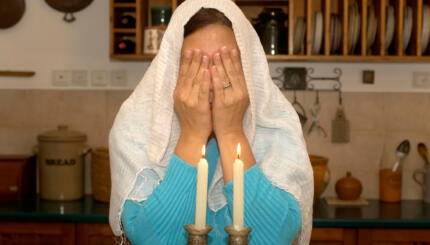is a day set apart from all others, differentiating between the sacred (kodesh) and the mundane (hol), between the work week and the day designated for rest, family, and spirituality. On Shabbat all activities associated with work are prohibited, and according to traditional Jewish law include formal employment as well as traveling, spending money, and carrying items outside the home, in the public domain.
The prohibition against carrying includes house keys, prayer books, canes or walkers, and even children who cannot walk on their own. Recognizing the difficulties this rule imposes, the sages of the Talmud devised a way to allow for carrying in public without breaking the rule. Through this means, called an , communities are able to turn a large area into one that is considered, for Jewish law purposes, a large private domain, in which items may be carried.
Symbolic Demarcation or Legal Fiction?
The term eruv refers to the act of mixing or combining, and is shorthand for eruv hazerot — the mixing of domains, in this case, the private (rashut hayahid) and the public (rashut harabim). An eruv does not allow for carrying items otherwise prohibited by Jewish law on Shabbat, such as money or cell phones.
Having an eruv does not mean that a city or neighborhood is enclosed entirely by a wall. Rather, the eruv can be comprised of a series of pre-existing structures (walls, fences, electrical poles and wires) and/or structures created expressly for the eruv, often a wire mounted on poles. In practice, then, the eruv is a symbolic demarcation of the private sphere, one that communities come together to create.

Help us keep Jewish knowledge accessible to millions of people around the world.
Your donation to My Jewish Learning fuels endless journeys of Jewish discovery. With your help, My Jewish Learning can continue to provide nonstop opportunities for learning, connection and growth.
To many people, the eruv sounds like a legal fiction, a way to circumvent the spirit and possibly letter of the law against carrying. To them, the eruv risks making the entire Jewish legal process seem absurd to non-Jews and non-observant Jews.
The talmudic Rabbis, however, were concerned with maintaining the integrity of the halakhic (Jewish legal) system while ensuring that the law is livable. Though the eruv makes use of a legal technicality, the fact that it is used — rather than allowing people to just carry anything, anywhere — is itself considered a form of respect for and submission to a legal system that is central and indispensable to traditionalist Jewish life.
The eruv helps enhance an aspect of Shabbat that the Rabbis considered vital — “oneg Shabbat,” the injunction to enjoy the Sabbath. With an eruv, Shabbat events are available to all families — young and old, mobile and less mobile — and individuals are able to carry house keys, reading glasses, or books outside their homes.
Wires and Walls

Public domains are defined by Jewish law as non-residential areas, including streets, thoroughfares, plazas (open areas), and highways. Private domains are residential areas, and were originally referred to as homes surrounded by a wall, considered closed off from the surrounding public domains.
A designated space may be considered a private domain only when several conditions are met: It must cover an area of at least 12 square feet and must be somehow demarcated from its surroundings — either by a wall of some kind or by its actual topography (it must be all lower or all higher than its surroundings). If a space is frequented by more than 600,000 people each day it is considered too big to turn “private” with an eruv (which is why a large city like New York cannot have a single eruv constructed around it, though individual neighborhoods do). And an eruv cannot encompass two separate public spaces, so for instance, it may not cross over a river that cuts through town.
When eruvim (the plural of eruv) or parts of eruvim are constructed (as opposed to using pre-existing structures), they generally consist of a wire surrounding the designated area. The eruv, therefore, is unlikely to be noticed except by those looking for it, which fulfills a talmudic guideline that the eruv be an integral part of the city, as unobtrusive and unnoticeable as possible.
Despite its symbolic nature, the eruv is intended to mimic in some way the form of walls, which need doorways –defined as two posts with a crossbeam over them, strong enough to withstand an ordinary wind. The eruv likewise needs openings, consisting of crossbeams resting or passing directly over the top of the doorpost (lehi). This is how modern rabbis arrived at the solution of having the eruv be made of a wire: The poles holding up the wire represent the “doorposts,” and the wire itself represents the “crossbeam.”
Many communities construct their eruvim by using lighting (or utility) poles to fulfill the requirement of doorposts and a continuous cable, string, or wire to represent the crossbeam. In order for this arrangement to be acceptable, the “beam” must rest directly above the top of the doorposts. Since this is not typically the case with utility poles — where the cable is attached either to the side or to an element that is held away from the pole — communities often attach a thin rod to the pole to serve as a substitute for the doorpost.
In areas where poles and lines do not exist, new arrangements must be made. The design of an eruv can make use of existing fences, overhead wires, hillsides, buildings, bridges, and other means that may serve as indicators of the eruv boundaries. This often requires communities to obtain permission from the appropriate authorities and property owners, and to work with local governments, power, telephone, and cable companies — a lengthy and often difficult process.
Who Maintains the Eruv?
Those who use an eruv are obliged to ensure that it is intact before carrying on Shabbat. In most cases there is a group that is responsible for maintaining the eruv, providing information regarding its status, conducting weekly inspections to ensure that it hasn’t been damaged, and dispensing repair crews when necessary. Many communities provide current information regarding their eruv by phone (eruv hotlines) and the Internet. They also provide maps delineating the exact boundaries of the eruv. (While Orthodox and Conservative understandings of Jewish law recognizes the restrictions that make an eruv necessary, other denominations generally do not.)
There are hundreds of eruvim in communities throughout the Jewish Diaspora (the U.S, Europe, South Africa, Australia), and many more in Israel. The challenge for these communities is incorporating the eruv into the streets of their cities. They must conduct traffic density studies in order to ensure that the number of people frequenting the area does not exceed 600,000 on a given day, while attempting to make use of existing urban structures to avoid wherever possible the need to construct the entire eruv themselves.
Controversies and Public Battles
Unlike other religious Jewish practices, which usually take place within private spaces, the eruv places signs in the public sphere; several communities have, therefore, encountered difficulty, controversy, and even major public battles in their attempt to receive the necessary authorization from authorities to establish their eruv.
READ: Eruv Battle in Hamptons Turns Ugly
The proposal submitted in 1992 for the North London eruv, for example, was met with public uproar, and was refused by the Town Planning Committee on the grounds that it would constitute a disturbance of visual amenity. Following an appeal made to the Secretary of State for the Environment, who found that the construction of the poles in chosen sites did not present any legal complication, the initial refusal was reversed.
Another controversy surrounding an eruv occurred in Palo Alto, California, in the summer of 1999. Residents of the city debated the eruv in a religious context, arguing over the distinction between temporary and permanent accommodations, and raising the concept of neighborliness as the underlying nature of a community. Some argued that the eruv created a walled city, and compromised property rights and the separation of church and State, while others asserted that the eruv is not only harmless, but is a positive contribution to the larger community.
In addition, there are other controversies regarding eruvim among Jews as well. Rabbis debate the nature and specifications of the eruv amongst themselves, attempting to ensure standards that fulfill all halakhic (Jewish law) requirements. Many secular Jews are concerned about increased interaction with Orthodox Jews if many new families move to a neighborhood because of the eruv; they fear they may face pressure to change their lifestyle and become more observant. A public discussion over a religious issue such as an eruv tends to bring up many fissures within Jewish communities, often leading to harsh battles between secular and observant Jews over Jewish practice in a modern, secular society.
The eruv has been referred to as “an invisible wall of freedom.” It brings about social liberation and an increase in the potential for interaction within the public sphere. It has also been nicknamed — using the Yiddish word for carrying –“the magic schlepping circle.” Since the social aspect of Shabbat is one of the most significant elements fostering community bonding, the eruv proves to be instrumental in enhancing the Shabbat experience, though disagreements and disputes surrounding its very nature and essence are likely to continue.
To find out if your community, or a community you are visiting, has an eruv, contact an Orthodox or Conservative synagogue or organization in the community. Many communities post eruv information, and even maps, online, so you may also find what you need by doing an Internet search for “eruv” and the community.
Sign up for My Jewish Learning’s RECHARGE, a weekly email with a collection of Shabbat readings and more to enhance your day of rest experience.



